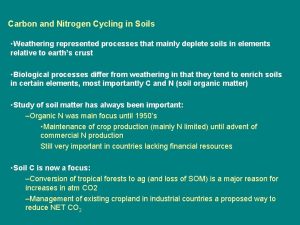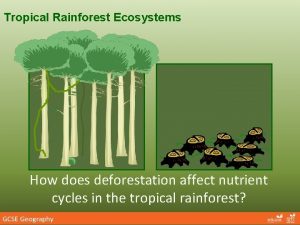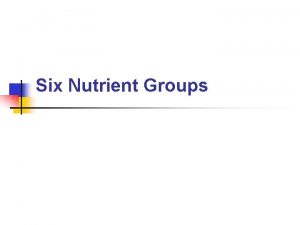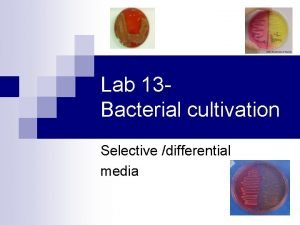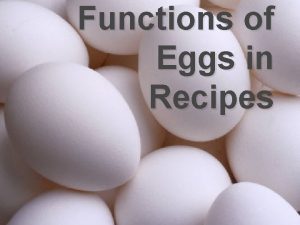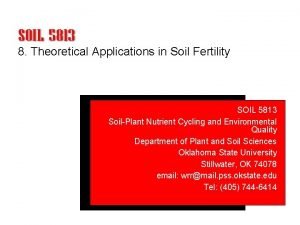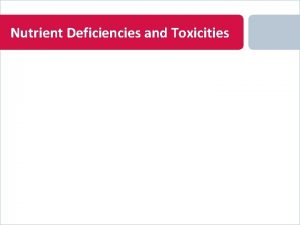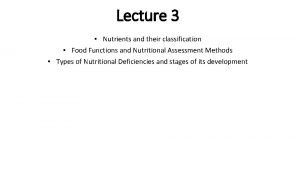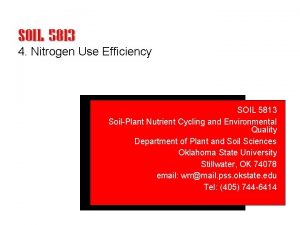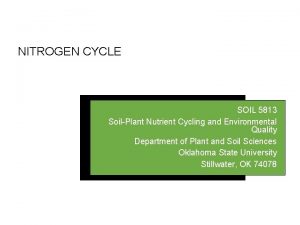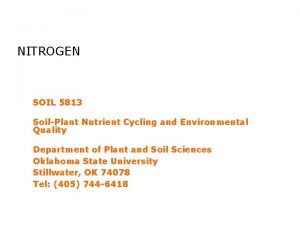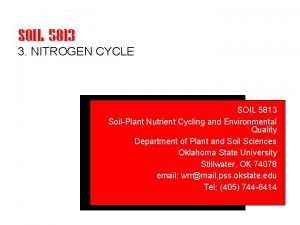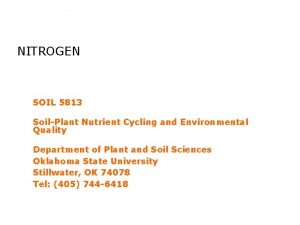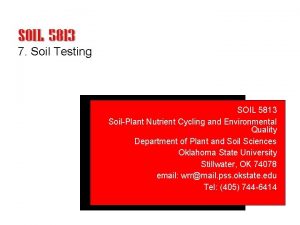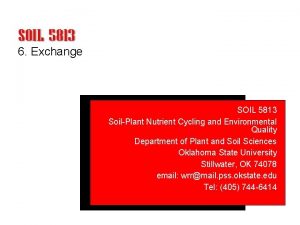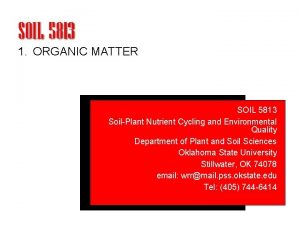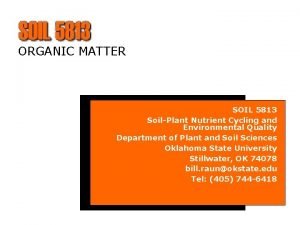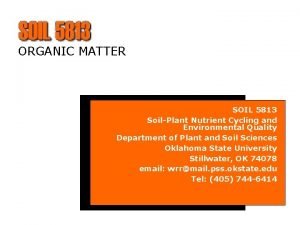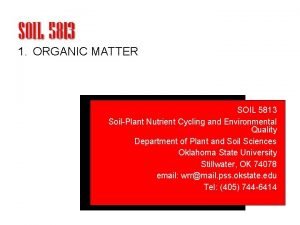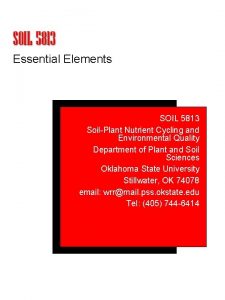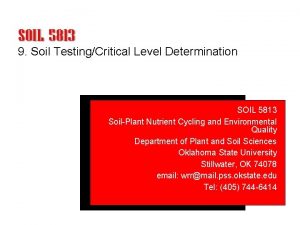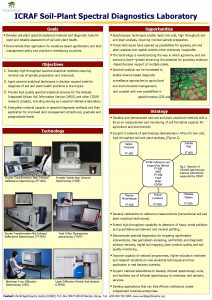Nitrogen Use Efficiency review SOIL 5813 SoilPlant Nutrient























- Slides: 23

Nitrogen Use Efficiency (review) SOIL 5813 Soil-Plant Nutrient Cycling and Environmental Quality Department of Plant and Soil Sciences Oklahoma State University Stillwater, OK 74078 email: wrr@mail. pss. okstate. edu Tel: (405) 744 -6414

4. Nitrogen Use Efficiency In grain production systems, N use efficiency seldom exceeds 50 percent. Variables which influence N use efficiency include a. Variety b. N source c. N application method d. Time of N application e. Tillage f. N rate (generally decreases with increasing N applied) g. Production system 1. Forage 2. Grain

Olson and Swallow, 1984 (27 -33% of the applied N fertilizer was removed by the grain following 5 years) h. Plant N loss i. Soil type (organic matter) Calculating N Use Efficiency using The Difference Method ___________________________________ _ Applied N Grain Yield N content N uptake Fertilizer Recovery kg/ha % ___________________________________ _ 0 1000 2. 0 20 - 50 1300 2. 1 27. 3 (27. 3 -20)/50=14. 6 100 2000 2. 2 44 (44 -20)/100=24 150 2000 2. 3 46 (46 -20)/150=17 ___________________________________ _

N use efficiency for grain production systems: 20 to 50%. Example does not include straw, thus, recovery levels are lower. Forage Production Systems (no grain) ARE NUE’s higher in forage production systems when compared to grain production systems?

– Analysis of forage production systems (Altom et al. , 1996) demonstrates that N use efficiency can be as high as 6070%. – plant is harvested prior to flowering, minimizing the potential for plant N loss. – plant N loss is known to be greater (flowering to maturity) – N use efficiencies in forage production systems do not decrease with increasing N applied as is normally found in grain production systems. – Suggests 'buffering' whereby increased N is lost at higher rates of applied N in grain production systems, but which cannot take place in forage production systems.

100 N use efficiency, % Time of N Applied Fall 90 Split Spring 80 70 60 50 50 75 100 150 200 N Rate, lb/acre Estimated fertilizer N use efficiency as affected by N rate and time of application, Burneyville, OK, 1979 -1992 (Altom et al. , 1996)

Moll et al. (1982) presence of two primary components of N use efficiency: (1) efficiency of absorption or uptake (Nt/Ns) (2) efficiency with which N absorbed is utilized to produce grain (Gw/Nt) Nt = total N in the plant at maturity (grain + stover) Ns = nitrogen supply or rate of fertilizer N Gw = grain weight (all expressed in the same units) Consideration of additional parameters not discussed in Moll et al. (1982) *plant N loss Maximum N accumulation has been found to occur at or near flowering in wheat and corn and not at harvest. In order to estimate plant N loss without the use of labeled N forms, the stage of growth where maximum N accumulation is known to occur needs to be identified. The amount of N remaining in the grain + straw or stover, is subtracted from the amount at maximum N accumulation to estimate potential plant N loss (difference method). Use of difference methods for estimating plant N loss are flawed since continued uptake is known to take place beyond flowering or the point of maximum N accumulation.

Figure 4. 1 Total N uptake in winter wheat with time and estimated loss following flowering.

Francis et al. (1993) Plant N losses accounted for 73% of the unaccountedfor N in 15 N balance calculations. Gaseous plant N losses could be greater when N supply was increased Maximum N accumulation in corn occurred soon after flowering (R 3 stage of growth). Francis et al. (1993): Importance of plant N loss on the development and interpretations of strategies to improve N fertilizer use efficiencies. Harper et al. (1987): 21% of the applied N fertilizer was lost as volatile NH 3 in wheat Francis et al. (1993): Failure to include plant N loss leads to overestimation of N loss from the soil by denitrification, leaching and ammonia volatilization.

NO 3 - + 2 e (nitrate reductase) NO 2 - + 6 e (nitrite reductase) NH 4+ Reduction of NO 3 - to NO 2 - is the rate limiting step in the transformation of N into amino forms. photosynthesis carbohydrates respiration reducing power carbon skeletons NADH or NADPH NO 3 NO 2 nitrate reductase ferredoxin siroheme nitrite reductase NH 3 amino acids

Does the plant wake up in the morning and turn on the TV to check the weather forecast, to see if it should assimilate NO 3 and attempt to form amino acids? Could we look at the forecast and attempt to communicate with the plant, letting it know that weather conditions will be good (or bad), thus proceeding with increased NO 3 uptake? If we could predict the weather, could this alter our N management strategy for mid-season N applications? Source? Method? Major pathways for assimilation of NH 3 1. incorporation into glutamic acid to form glutamine, a reaction catalyzd by glutamine synthetase (Olson and Kurtz, 1982) 2. Reaction of NH 3 and CO 2 to form carbamyl phosphate, which in turn is converted to the amino acid arginine. 3. Biosynthesis of amides by combination of NH 3 with an amino acid. In this way aspartic acid is converted to the amide, asparagine

VEGETATIVE R-NH 2 NO 3 REPRODUCTIVE R-NH 2 Total N NH 4 moisture heat Total N NH 3 NO 2 nitrate reductase NH 3 amino acids nitrite reductase NO 3 - + 2 e (nitrate reductase) NO 2 - + 6 e (nitrite reductase) NH 4+

Means over N rate and variety for protein, NUE components and estimated plant N loss, Perkins, OK 1995 _____________________________________________ Protein N-use Uptake N-utilization Fraction of Grain yield/ N loss % efficiency N translocated grain N (kg ha-1) (Gw/Ns) (Nt/ Ns) (Gw/Nt) to grain(Ng/Nt) (Gw/Ng) (Nf-(Ng+Nst) N rate, kg ha-1 ---------------------------- means ---------------------------- 0 14. 8 0 0 23. 2 0. 60 38. 8 16. 4 45 15. 9 23. 3 1. 0 22. 9 0. 63 36. 5 25. 0 90 17. 4 11. 0 0. 6 20. 2 0. 61 33. 2 25. 8 180 17. 6 7. 0 0. 4 20. 5 0. 62 33. 5 31. 4 SED 0. 40 1. 1 0. 05 1. 12 0. 03 0. 89 6. 74 Chisholm 16. 3 11. 8 0. 5 22. 4 0. 6 35. 3 21. 8 a Karl 17. 5 13. 1 0. 6 23. 0 0. 7 33. 0 26. 6 a 2180 17. 4 18. 1 0. 8 22. 7 0. 7 33. 4 27. 9 a TAM W-101 15. 5 11. 7 0. 6 21. 4 0. 6 37. 4 24. 7 a Longhorn 15. 0 14. 7 0. 8 19. 5 0. 5 38. 5 22. 3 a SED 0. 45 1. 5 0. 07 1. 27 0. 04 1. 18 7. 33 Variety: _____________________________________________

NUE for food production 1. efficiency of the plant to assimilate applied N 2. once assimilated, the ability retain & incorporate N into the grain 3. efficiency of the soil to supply/retain applied N for plant assimilation over long periods of time 4. composite system efficiency.

Components of NUE Uptake efficiency estimated as Nf/Ns (Eup) instead of Nt/Ns (Eha). More N is assimilated at earlier stages of growth, therefore, uptake efficiency should be estimated at the stage of maximum N accumulation and not at maturity when less N can be accounted for. The component Nt/Ns as proposed by Moll et al. would be better defined as harvest uptake efficiency or physiological maturity uptake efficiency. We define uptake efficiency as the stage where maximum N is taken up by the plant divided by the N supplied.

1. Uptake efficiency Eup=Nf/Ns Unlike the description by Moll et al. (1982), uptake efficiency should be partitioned into two separate components since plant N loss (from flowering to maturity) can be significant. Fraction of N translocated to the grain should be estimated as Ng/Nf and not Ng/Nt as proposed by Moll et al. (1982) since more N was accumulated in the plant at an earlier stage of growth. Plants losing significant quantities of N as NH 3 would have very high fractions of N translocated to the grain when calculated using Nt instead of Nf. In terms of plant breeding efforts, this could be a highly misleading statistic. A second component, the translocation index is proposed that would reflect the ability of a plant genotype or management practice to incorporate N accumulated at flowering into the grain.

2. fraction of N translocated to the grain 2. translocation index Et=Ng/Nf Eti=Ng/Nf * (1/Nl) Ability of the soil-plant system to utilize outside sources of N for food production (grain or forage) depends on the efficiency of storage in the soil. The efficiency of the soil to supply N to plants is strongly influenced by immobilization and mineralization with changing climate and environment. Over a growing season, storage efficiency will be equal to the difference between fertilizer N added (Ns) minus maximum plant uptake (Nf) plus the difference between total soil N at the beginning and end of the season, all divided by fertilizer N added. Esg = [(Ns-Nf)-(St 1 -St 2)]/Ns 3. soil (management system) supply efficiency, Es=Ns/(Sv+Sd+Sl) where Sv, Sd and Sl are estimates of soil volatilization, denitrification and leaching losses from the soil, respectively. Lastly, a composite estimate of efficiency for the entire system (soil and plant) can be estimated as follows 4. composite system efficiency Ec=Eup*Es=Nf/(Sv+Sd+Sl)

It is important to note that these efficiency parameters can be determined without having to determine total N in the soil. Avoiding total soil N analyses is noteworthy since the precision of present analytical procedures (Kjeldahl or dry combustion) approach ± 0. 01%. This translates into approximately ± 220 kg N/ha (depending on soil bulk density) which is often greater than the rate of N applied, thus restricting the ability to detect N treatment differences. Will Increased NUE lead to Increased NO 3 leaching? Data from Kanampiu et al. (1995) NUE Sinks: Total N Applied Plant N uptake (at flowering) Final Grain N uptake Plant N loss Denitrification Immobilization Balance Leaching Increased NUE No Change ------- kg / ha -------180 68 71 42 40 26 31 10 15 80 80 22 14 ? ?

Component Abbreviation Unit Grain weight Nitrogen supply (rate of fertilizer N) Total N in the plant at maturity (grain + stover) N accumulation after silking N accumulated in grain at harvest Gw Ns Nt Na Ng kg ha-1 kg ha-1 Stage of growth where N accumulated in the plant is at a maximum, at or near flowering Nf kg ha-1 Total N accumulated in the straw at harvest Nst kg ha-1 Estimate of gaseous loss of N from the plant Nl =Nf-(Ng+Nst) kg ha-1 Flowering uptake efficiency Eup=Nf/Ns Harvest uptake efficiency (Uptake efficiency) Eha=Nt/Ns Translocation index (accumulated N at flowering translocated to the grain) Eti =Ng/Nf * (1/Nl) Soil supply efficiency Composite system efficiency Utilization efficiency Efficiency of use Grain produced per unit of grain N Fraction of total N translocated to grain Fraction of total N accumulated after silking Ratio of N translocated to grain to N accumulated after silking Es=Ns/(Sv+Sd+Sl) Ec=Eup*Es=Nf/(Sv+Sd+SI) Gw/Nt Gw/Ns Gw/Ng Et=Ng/Nt Na/Nt Ng/Na


N Discussion Magruder Plots 1892: 4. 0 % organic matter = 0. 35+ 1. 8 OC OC = 2. 03 TN = 0. 16 Pb = 1. 623 (0 -12") lb N/ac = Pb * ppm N * 2. 7194 = 1. 623 * 1600 * 2. 7194 = 7061 + 10 lbs N/year in the rainfall = 1050 (105 * 10) = 8111 1997 OC = 0. 62 TN = 0. 0694 lb N/ac = 1. 623*694 * 2. 7194 =3063 Difference: 8111 - 3063 = 5048 lbs N

Grain N removal 14. 6 bu/ac * 60 lb/bu = 876 lbs * 105 years = 91980 lbs grain 91980 lbs * 0. 022086 %N = 2031 lbs N Plant N loss 10. 7 lb/ac/yr (Kanampiu et al. , 1995, avg. of 2 experiments) 105 * 10. 7 = 1130 lbs N Denitrification 2. 85 lb/ac/yr (Aulakh et al. 1984) 105 * 2. 85 = 300 lbs N Balance 1537 lbs N Year 1 denitrification, ammonification Denitrification, ug/g = 50. 0 * OC + 6. 2 (Burford and Bremner, 1975, p. 391) = 50. 0 * 2. 03 + 6. 2 = 107. 7 ug/g = 107. 7 * 1. 623 * 2. 7194 = 475. 34 lb/ac (0 -12") New Balance 1062 lb N/ac (10. 11 lb N/ac/yr unaccounted)

Not included in this balance sheet is the amount of N that would be lost via ammonification. Denitrification losses the first year were likely much higher since increased NO 3 -N would have been present as a result of mineralized N from a very large total N pool. Burford and Bremner (1975) applied the equivalent of 800 lb NO 3 -N/ac and found that denitrification losses were extremely high. Although their work has little relevance to annual denitrification losses expected under field conditions, it does provide some insight into what might have happened in the first year when soils were first tilled. Miscellaneous When adequate inorganic N was present, the incorporation of straw in conventional till or the application of straw on the surface of zero till approximately doubled the accumulative gaseous N losses (increased supply of energy to denitrifying organisms). Aulakh et al. (1984) From 71 to 77% of the surface applied fertilizer N remaining in the profiles was in the 0 to 0. 1 m soil layers (Olson and Swallow, 1984). Late N application can be efficiently taken up by plants, and does not decrease soil N uptake. To achieve acceptable grain protein levels for bread wheat in this irrigated cropping system, N should be supplied late in the season to improve N uptake during grain fill (Wuest and Cassman, 1992)
 Nutrient broth vs nutrient agar
Nutrient broth vs nutrient agar Allocative efficiency vs productive efficiency
Allocative efficiency vs productive efficiency Productively efficient vs allocatively efficient
Productively efficient vs allocatively efficient Productively efficient vs allocatively efficient
Productively efficient vs allocatively efficient Carbon and nitrogen cycling in soil:
Carbon and nitrogen cycling in soil: Main source of nitrogen
Main source of nitrogen Living soil vs dead soil
Living soil vs dead soil Living soil vs dead soil
Living soil vs dead soil Flexibility and efficiency of use
Flexibility and efficiency of use Radial artery in the hand
Radial artery in the hand How does deforestation affect the nutrient cycle
How does deforestation affect the nutrient cycle Nnn plant protein
Nnn plant protein Nutrient agar with tellurite is selective/differential for
Nutrient agar with tellurite is selective/differential for Emulsifier recipes
Emulsifier recipes Nutrient cycle in the serengeti
Nutrient cycle in the serengeti Deciduous woodlands
Deciduous woodlands Foods used in nutrition activities should be nutrient-dense
Foods used in nutrition activities should be nutrient-dense Bray nutrient mobility concept
Bray nutrient mobility concept Nutrient chain foldable
Nutrient chain foldable Journey 2050 student handout 2 word search
Journey 2050 student handout 2 word search Chlorsis
Chlorsis Nutrient basics
Nutrient basics Funtions of carbohydrate
Funtions of carbohydrate Journey 2050 student handout 2 word search
Journey 2050 student handout 2 word search




